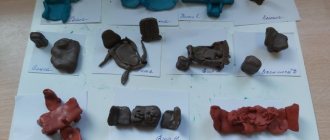Summary of the didactic game in the first junior group “Three Bears”
Title: Summary of the didactic game “Three Bears” Nomination: Kindergarten, Educational games, Didactic, First junior group Author: Olga Nikolaevna Kuznetsova Position: teacher Place of work: MBDOU “Kindergarten No. 79” Location: Kamensk-Uralsky, Sverdlovsk region
Summary of the didactic game in the first junior group “Three Bears”
Integration of educational areas “Cognitive development”, “Socio-communicative development”
Expected outcome: Children demonstrate the ability to cooperate with other children and with adults; take part in games, show interest in the gaming activities of their peers. show positive emotions during activities; show emotional responsiveness; act alongside peers without disturbing them; show interest in playing together in small groups; speech becomes a full-fledged means of communication with other children.
show a desire to act independently, orient themselves in space; answer the simplest questions, carry out the simplest instructions from an adult; distinguish between large and small objects, compare, correlate, establish the identity of objects by size, name their size.
Triune goal: 1) Educational: to cultivate a good attitude towards toys, a desire to help others, and take care of each other. 2) Developmental: develop mental operations, speech and attention. 3) Educational: consolidate knowledge about the concepts of more, less, teach to compare, correlate, establish the identity of objects by size.
Game goal: Give tea to the bear family. Game task: help Mishutka place the dishes on the table.
Game rules: children go out one at a time; consistently follow the order of actions: cover the table with a tablecloth, put napkins, mugs, lay out spoons, arrange stools. Game actions: select objects by size, name them.
Equipment: three toy bears of different sizes, three mugs of different sizes, three spoons of different sizes, a tablecloth, napkins, a doll table with three stools of different sizes, a recording of a round dance song on a tape recorder.
Progress of the game:
1. Organizational moment. Objective of the stage: To gather children's attention.
— Guys, try to guess this riddle:
He sleeps in a den and sucks his paw, And in a sweet dream he sees honey. Who is this? (Children stand with the teacher and answer questions.)
He sleeps in a den in winter, Little by little snores, And when he wakes up, well, roar, What is his name? - (bear).
- Guys, who can show how bears walk? That's right, they waddle from foot to foot, clubfoot. (Children imitate the movements of a bear.) - Guys, can you name fairy tales where there were bears? (The teacher shows illustrations of bears. Encourages children to answer. Children remember that they are familiar with the fairy tales “Masha and the Bear”, “The Three Bears” and other fairy tales where there is a bear.)
2. Motivational - target stage. The task of the stage: To motivate children to play activities, to create conditions for accepting the goal. Surprise moment.
- Oh, guys, do you hear someone knocking? - Who came to us? Let's see. (The teacher goes out the door and immediately comes back with a toy Teddy Bear.) - Guys, look who came to visit us? - This is a bear, his name is Mishutka. He came to us from the fairy tale “The Three Bears”. Guys, Mishutka asks us to help him. Mishutka wants to set the table properly to make her mother happy, and then drink tea with the whole family. And he never did this. Let's help him set the table correctly and arrange the dishes according to size. — Shall we help Mishutka? Of course, we will help, you and I know which item is larger and which is smaller. (Children listen and react emotionally, participate in dialogue, agree.) 3. Joint planning of the game. Task: Identify game rules and game actions. Game rules: children go out one at a time; consistently following the order of actions: cover the table with a tablecloth, put napkins, mugs, spoons. Game actions: place mugs, arrange spoons, select objects by size, name them. Children with a teacher sit on chairs in a semicircle not far from the table. Guys, Mishutka needs to set the table. What will we do first? (Children's answers.) Let's remember how they set the table? Here we have a table, dishes, tablecloth, napkins. (The teacher shows these objects. Children offer options for the sequence of actions.
The teacher, with leading questions, helps the children decide on the sequence of actions and the size of the dishes for each member of the bear family.) First they cover the tablecloth, then put napkins, then mugs and then put spoons.
Papa bear is big. What do you think: will he drink tea from the largest or from the smallest mug? (Children answer, react emotionally.) Here we have 3 different mugs, of which you will need to choose the largest one. But we have 3 spoons, of which you will also need to choose the largest one for Papa Bear. And Mishutka is the smallest in the family. Will it be convenient for him to drink from a large or small mug?
- So, what kind of mug should we give to Mishutka?
- What spoon? That's right, you will need to choose the smallest one. Guys, you will come out one by one, one at a time, in the same order as you sit on the chairs and show Mishutka and all the guys how to set the table. (Children participate in dialogue, react emotionally, help make the right choice of sequence of actions and sizes of dishes.)
4. Implementation of the game plan. Task of the stage: Implementation of game actions: take turns setting the table, distinguishing between large and small objects, comparing, correlating, establishing the identity of objects by size, naming their size.
(The teacher corrects and directs the children’s actions, and the children participate in dialogue and carry out assignments.)
- Sit down Mishutka next to the guys. - Look here carefully. The teacher asks one child to come out: “Come out, Nastenka.” Here is the table, here are the dishes, the tablecloth. - What will you do first? - That's right, lay out the tablecloth. (The child carries out the assignment and, at the request of the teacher, pronounces his actions.) - Well done, sit down. (Then the children come out one at a time, one at a time, in the same order as they sit on the chairs at the table.) - the next one puts down napkins, - the next child chooses the largest mug for daddy bear. - the next one chooses the smallest mug for Mishutka himself. - the next one chooses the largest spoon and puts it next to the large mug - the next one selects stools for the bears, etc.
(The teacher corrects and directs the children’s actions, and the children participate in dialogue, carry out assignments and comment on their actions.)
5. Final part. Summarizing. Objective of the stage: Show achievement of the game task: children demonstrate the ability to cooperate with other children and with adults.
- Guys, do you hear someone coming? (The teacher brings two large bears to the group.) - Mishutka’s parents came: this is Papa Bear, he is big and shaggy. And this is the mother bear, she is smaller. (The teacher, on behalf of the bears, communicates with the children, on behalf of Mishutka, invites the bears to the table to drink tea and says that the guys helped him, expresses gratitude to the children for their help) The bears drink tea. Mishutka invites everyone to dance joyfully in a general round dance. (Music sounds, the teacher hands the bears to the children, everyone dances together)
Date modified: January 14, 2022 Date published: January 7, 2017



